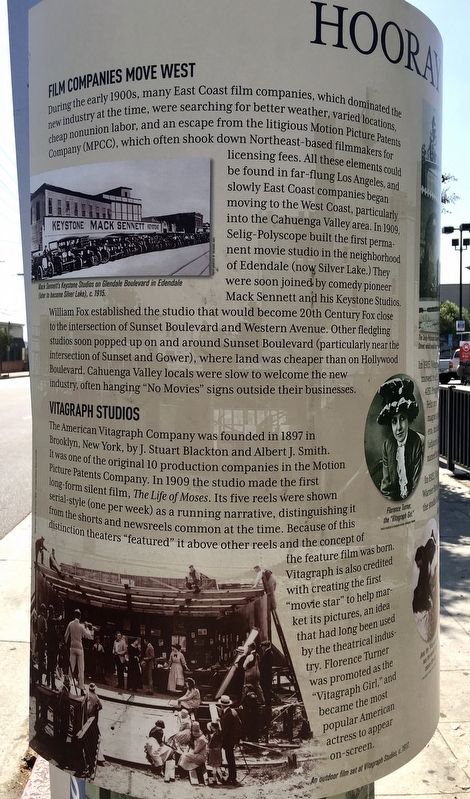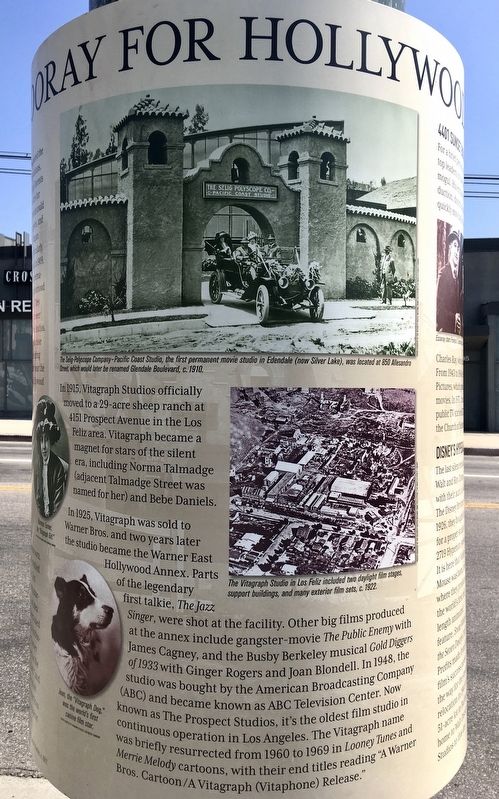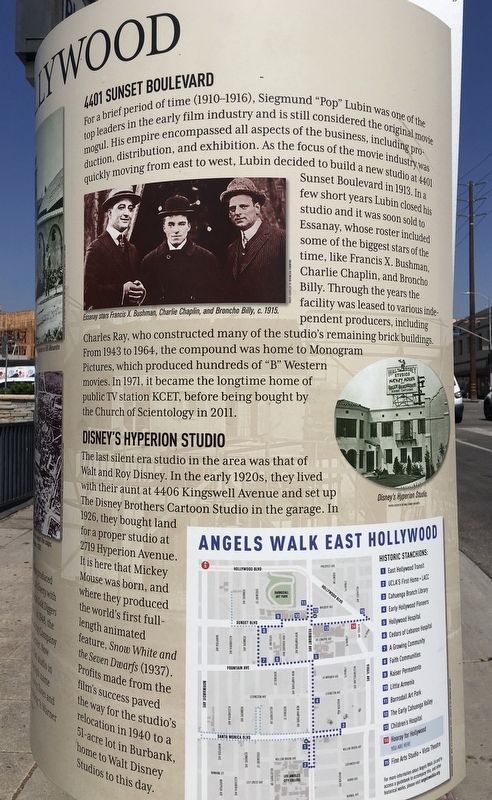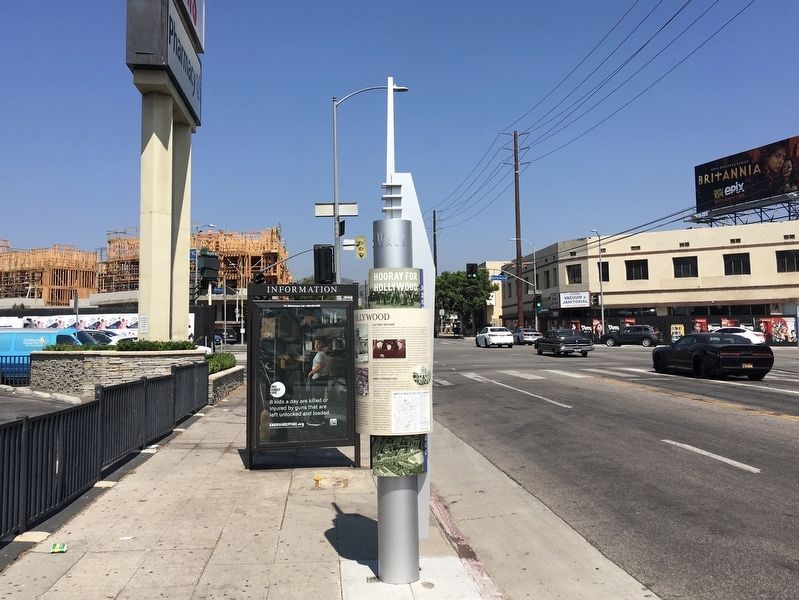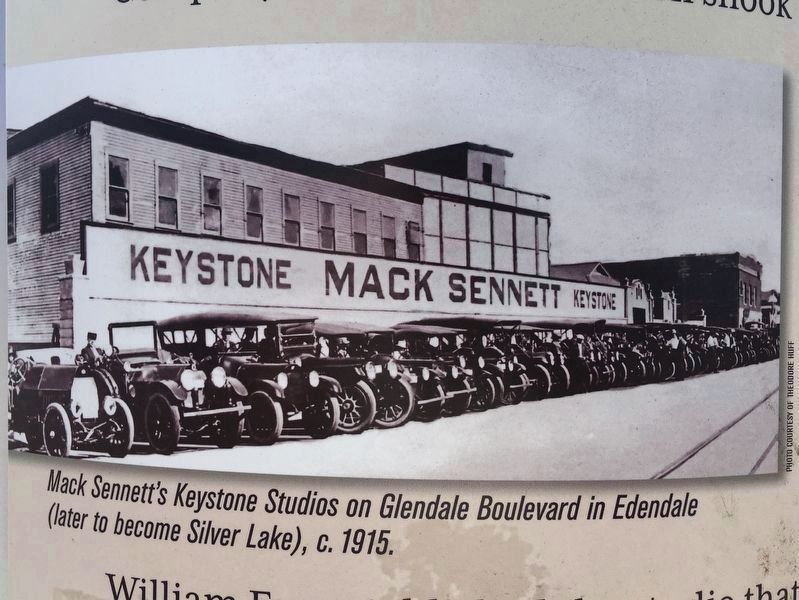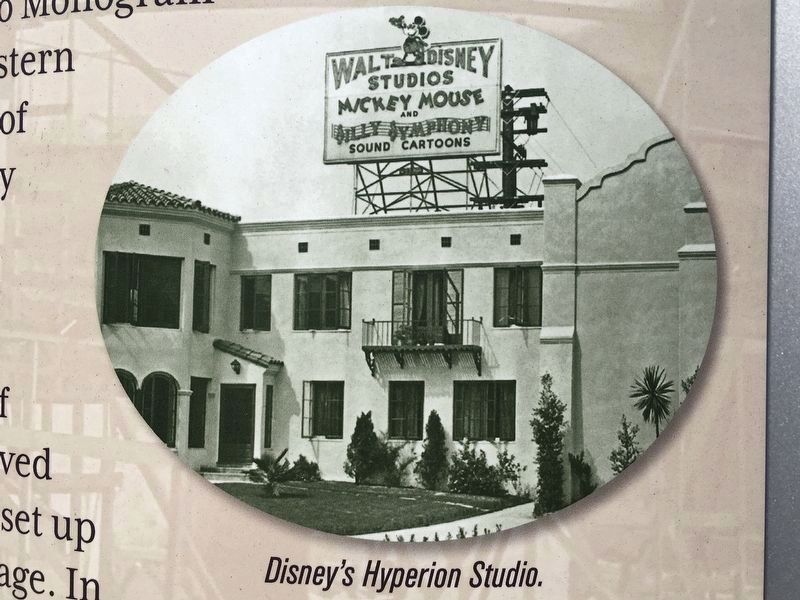East Hollywood in Los Angeles in Los Angeles County, California — The American West (Pacific Coastal)
Hooray for Hollywood
Film Companies Move West
During the early 1900s, many East Coast film companies, which dominated the new industry at the time, were searching for better weather, varied locations, cheap nonunion labor, and an escape from the litigious Motion Picture Patents Company (MPCC), which often shook down Northeast-based filmmakers for licensing fees. All these elements could be found in far-flung Los Angeles, and slowly East Coast companies began moving to the West Coast, particularly into the Cahuenga Valley area. In 1909, Selig-Polyscope built the first permanent movie studio in the neighborhood of Edendale (now Silver Lake.) They were soon joined by comedy pioneer Mack Sennett and his Keystone Studios. William Fox established the studio that would become 20th Century Fox close to the intersection of Sunset Boulevard and Western Avenue. Other fledgling studios soon popped up on and around Sunset Boulevard (particularly near the intersection of Sunset and Gower), where land was cheaper than on Hollywood Boulevard. Cahuenga Valley locals were slow to welcome the new industry, often hanging "No Movies" signs outside their businesses.
Vitagraph Studios
The American Vitagraph Company was founded in 1897 in Brooklyn, New York, by J. Stuart Blackton and Albert J. Smith. It was one of the original 10 production companies in the Motion Picture Patents Company. In 1909 the studio made the first long-form silent film, The Life of Moses. Its five reels were shown serial-style (one per week) as a running narrative, distinguishing it from the shorts and newsreels common at the time. Because of this distinction theaters "featured" it above other reels and the concept of the feature film was born. Vitagraph is also credited with creating the first "movie star" to help mar-ket its pictures, an idea that had long been used by the theatrical industry. Florence Turner was promoted as the "Vitagraph Girl," and became the most popular American actress to appear on-screen.
In 1915, Vitagraph Studios officially moved to a 29-acre sheep ranch at 4151 Prospect Avenue in the Los Feliz area. Vitagraph became a magnet for stars of the silent era, including Norma Talmadge (adjacent Talmadge Street was named for her) and Bebe Daniels. In 1925, Vitagraph was sold to Warner Bros. and two years later the studio became the Warner East Hollywood Annex. Parts of the legendary first talkie, The Jazz Singer, were shot at the facility. Other big films produced at the annex include gangster-movie The Public Enemy with James Cagney, and the Busby Berkeley musical Gold Diggers of 1933 with Ginger Rogers and Joan Blondell. In 1948, the studio was bought by the American Broadcasting Company (ABC) and became known as ABC Television Center. Now known as The Prospect Studios, it's the oldest film studio in continuous operation in Los Angeles. The Vitagraph name was briefly resurrected from 1960 to 1969 in Looney Tunes and Merrie Melody cartoons, with their end titles reading “A Warner Bros. Cartoon / A Vitagraph (Vitaphone) Release."
4401 Sunset Boulevard
For a brief period of time (1910-1916), Siegmund "Pop" Lubin was one of the top leaders in the early film industry and is still considered the original movie mogul. His empire encompassed all aspects of the business, including production, distribution, and exhibition. As the focus of the movie industry was quickly moving from east to west, Lubin decided to build a new studio at 4401 Sunset Boulevard in 1913. In a few short years Lubin closed his studio and it was soon sold to Essanay, whose roster included some of the biggest stars of the time, like Francis X. Bushman, Charlie Chaplin, and Broncho Billy. Through the years the facility was leased to various independent producers, including Charles Ray, who constructed many of the studio's remaining brick buildings. From 1943 to 1964, the compound was home to Monogram Pictures, which produced hundreds of "B" Western movies. In 1971, it became the longtime home of public TV station KCET, before being bought by the Church of Scientology in 2011.
Disney’s Hyperion Studio
The last silent era studio in the area was that of Walt and Roy Disney. In the early 1920s, they lived with their aunt at 4406 Kingswell Avenue and set up The Disney Brothers Cartoon Studio in the garage. In 1926, they bought land for a proper studio at 2719 Hyperion Avenue. It is here that Mickey Mouse was born, and where they produced the world's first full-length animated feature, Snow White and the Seven Dwarfs (1937). Profits made from the film's success paved the way for the studio's relocation in 1940 to a 51-acre lot in Burbank, home to Walt Disney Studios to this day.
Erected 2019 by City of Los Angeles.
Topics. This historical marker is listed in these topic lists: Entertainment • Industry & Commerce.
Location. 34° 5.875′ N, 118° 17.25′ W. Marker is in Los Angeles, California, in Los Angeles County. It is in East Hollywood. Marker is on Virgil Avenue just south of Sunset Boulevard, on the right when traveling south. Touch for map. Marker is at or near this postal address: 4520 Sunset Blvd, Los Angeles CA 90027, United States of America. Touch for directions.
Other nearby markers. At least 8 other markers are within walking distance of this marker. El Pueblo de Los Angeles (about 700 feet away, measured in a direct line); KCET Studios (approx. 0.2 miles away); Barnsdall Art Park (approx. ¼ mile away); Charlotte and Robert Disney House (approx. 0.3 miles away); Kaiser Permanente (approx. 0.4 miles away); Arts and Crafts Building (approx. 0.4 miles away); Hollyhock House (approx. 0.4 miles away); Cahuenga Branch Library (approx. half a mile away). Touch for a list and map of all markers in Los Angeles.
Related marker. Click here for another marker that is related to this marker. - Mack Sennett Studios.
Also see . . . Angels Walk L.A. Self-guided walking tours of historic neighborhoods in Los Angeles. The Hooray for Hollywood marker is part of the East Hollywood walk. (Submitted on October 20, 2020.)
Credits. This page was last revised on June 22, 2023. It was originally submitted on October 20, 2020, by Craig Baker of Sylmar, California. This page has been viewed 334 times since then and 59 times this year. Photos: 1, 2, 3, 4, 5, 6. submitted on October 20, 2020, by Craig Baker of Sylmar, California. • Syd Whittle was the editor who published this page.
